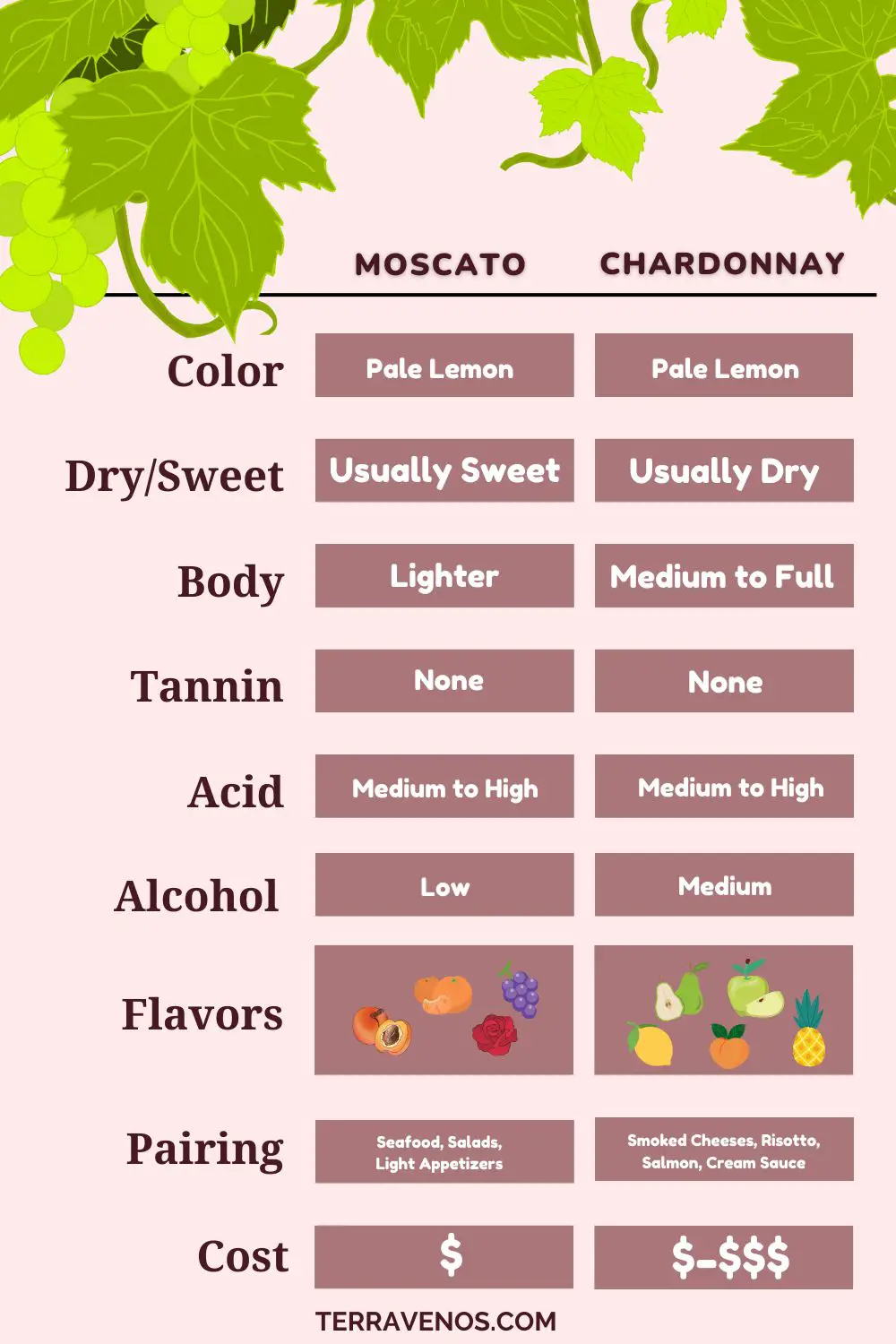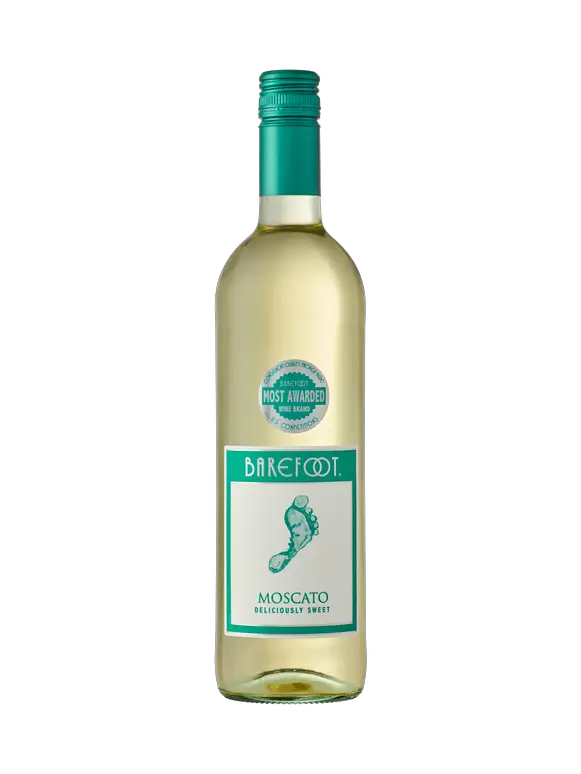
| Characteristics | Moscato | Chardonnay |
|---|---|---|
| Hue | Pale lemon | Pale to medium lemon |
| Color | White | White |
| Aromas | Musky, orange blossom, tropical fruit | Citrus, stone, and sometimes tropical fruit |
| Sweetness | Mostly sweet | Almost always dry |
| Acid | Medium to high | Medium to Medium + |
| Alcohol (%) | 5-11% | 11%-15% |
| Body | Light | Medium to full |
| Intensity | Medium | Medium (less than Moscato) |
| Bubbles | Slightly effervescent | Still (unless made into a Champagne style wine |
| Grape | Moscato Bianco | Chardonnay |
| Key Growing Regions | Italy, California, Australia | Burgundy, California, Australia, Chile |
| Classic Pairings | Desserts, fruits, light cheeses | Creamy sauces, grilled white meats |
| Price Range | $5-$20 | $8-$50+ |
Moscato vs Chardonnay is a natural comparison; two white wines that are widely available.
Moscato is always sweet, lighter, more aromatic, and bubbly, with tropical fruits and floral notes. Chardonnay is usually dry, and fuller-bodied, with citrus, tree, stone, or tropical fruits. Both wines are widely available. Moscato is generally less expensive than Chardonnay.
Here’s what you need to know about Moscato vs Chardonnay.
- What Is Moscato Wine?
- Chardonnay Basics: Classic White Wine
- Wine Comparison: Moscato vs Chardonnay
- Moscato vs. Chardonnay Winemaking
- Moscato vs. Chardonnay: Food Pairings and Serving Temperature
- Which Is More Expensive, Moscato vs Chardonnay?
- Which Is Better, Moscato vs Chardonnay?
- Final Thoughts – Moscato vs Chardonnay?
- Thirsty for More?
What Is Moscato Wine?

If you’re comparing Moscato and Chardonnay, then you’re probably thinking about the light, sweetish white wine that has a slight effervescence to it. The most famous of this style of wine is Moscato d’Asti DOC, from Italy’s northwestern Piemonte region.
Jargon Alert: DOC stands for Denominazione di Origine Controllata (literally Controlled Designation of Origin), which is a demarcated region where a wine style comes from in Italy. Here are all of the Italian wine classifications explained (just in case you’re curious).
Moscato d’Asti, or just Asti, is made from a cultivar of Moscato grapes (there’s no actual grape called “Muscat”, which is unhelpful. The grape that makes your lovely fizzy Moscato is Moscato Bianco, or Muscat Blanc a Petit Grains, one of the most perfumed and aromatic of the Muscat family.
Helpful Tip: Here’s a rundown of everything you need to know about Muscat and its many versions.
Chardonnay Basics: Classic White Wine

Chardonnay, a classic white grape variety, offers a diverse range of styles. With origins in the Burgundy region of France, Chardonnay has spread its influence globally, producing age-worthy wines. Chardonnay showcases a medium to full body.
Fun Wine Fact: Chardonnay is often used in the production of sparkling wines, including Champagne.
Chardonnays come in a range of flavors and styles. It’s often called a “winemaker’s” grape because it can be crafted into different expressions in the winery. The growing climate will play a major factor in how Chardonnay tastes. Warmer climates craft Chardonnays with tropical notes, like mango and pineapple. Cooler climate Chardonnays will have more citrus and green notes.
Fun Wine Fact: Chardonnay is the most popular and widely planted white grape variety in the world.
Wine Comparison: Moscato vs Chardonnay
Here’s a quick side-by-side that covers the most common styles of Moscato vs Chardonnay.
Moscato Wine Profile
- Sweetness: Moscato is typically produced in a sweet style, offering noticeable residual sugar.
- Alcohol: Moscato wines generally have a low alcohol content, ranging from around 5%-8% ABV.
- Body: Known for its light body, Moscato provides a refreshing and easy-drinking experience.
- Acid: Depending on the Chardonnay, most Moscatos will have slightly more acid than Chardonnay
- Flavor and Aroma Intensity: Moscato exhibits delicate tropical fruit flavors and floral aromas.
- Flavors: The flavor profile often includes notes of peach, apricot, orange blossom, and sometimes a touch of honey.
Chardonnay Wine Profile
- Sweetness: Chardonnay wines are typically dry and less sweet than Moscato
- Alcohol: Chardonnay wines typically have a moderate to high alcohol content, ranging from around 12% to 15% ABV.
- Body: Chardonnay is known for its medium to full body, providing a rich and complex drinking experience. Much fuller than Moscato.
- Acid: Chardonnay showcases a moderate acidity, offering a balanced structure.
- Flavor and Aroma Intensity: Chardonnay exhibits diverse aromas, from citrus and green apple to tropical fruits, vanilla, and buttery nuances. It isn’t as aromatic as Moscato wine.
- Flavors: The flavor profile can include a range of fruit, oak, and mineral notes, influenced by winemaking techniques.
Are Moscato and Chardonnay Similar?
Moscato and Chardonnay are both white wines and can be made into sparkling styles, but other than that, they’re pretty distinctive in their flavor profiles and typical styles.
What Is the Difference Between Moscato and Chardonnay?
What you’re probably thinking of as Moscato is always crafted in a sweet, slightly bubbly style that has a lovely musk, or perfumed aroma. Chardonnay is almost always crafted in a dry style with a fuller body and not nearly as aromatic as Moscato. Moscato will be lower alcohol than Chardonnay.
Helpful Wine Buying Tip: Here’s a quick guide on how to figure out if the bottle of wine you’re holding is sweet or dry.
Moscato vs. Chardonnay Winemaking
Winemakers craft Moscato to capture the CO2 produced during fermentation. This process results in the slightly effervescent quality along with the sweet nature of Moscato wines. Chardonnay is typically fermented dry, and can be oaked, which imparts toast, caramel, and even butterscotch notes in your Chardonnay wine. Because Moscato is an aromatic wine, winemakers typically protect the fermenting wine throughout production to retain those fruity aroma molecules. This is less of a concern with Chardonnay.
Helpful Tip: Here’s what you need to know about wine fermentation.
Moscato vs. Chardonnay: Food Pairings and Serving Temperature

Moscato’s sweet and fruity character makes it a versatile companion for a variety of fruit salads, spicy dishes, and as a refreshing aperitif. Chardonnay, with its fuller body, pairs exceptionally well with a range of foods, including pasta with cream sauce, risottos, and poached white fish.
Personal Note: I love drinking both of these wines on their own, no need for food pairing.
Both Chardonnay and Moscato are best enjoyed chilled. Place them in the refrigerator for a few hours before serving. Leave your Chardonnay to warm up for 15-20 minutes to help open up the wine.
Discover More:
Which Is More Expensive, Moscato vs Chardonnay?

When comparing the prices of Moscato and Chardonnay, it’s natural to wonder about how much each wine costs.
Moscato Cost
Entry-level Moscato wines are typically affordable, ranging from $5-$8 USD per bottle. If wine affordability is something you’re thinking about, Moscato is an accessible choice without compromising on the sweet and fruity flavors that make this wine so popular. If you are looking for premium Moscato, there are higher-priced Moscato wines available. These bottles, priced around $15 to $20 or higher, offer a more complex and nuanced drinking experience.
Chardonnay Cost
Similar to Moscato, entry-level Chardonnay wines also fall within accessible price ranges, usually ranging from $8 to $12 USD per bottle. These wines tend to be from warmer climates and showcase more tropical fruits, higher alcohol, and a fuller body.
On the premium side, Chardonnay will have more intense, layered flavors and aging potential. Premium Chardonnay wines sourced from renowned regions can have prices ranging from $30 to $50 or more.
Which Is Better, Moscato vs Chardonnay?
If you enjoy sweet, fruity, slightly bubbly white wine, Moscato will be better for you. If you enjoy fuller-bodied white wines with higher alcohol and more nuanced aromatics, then Chardonnay is a great choice.
Final Thoughts – Moscato vs Chardonnay?
Both Moscato and Chardonnay present delightfully distinctive white wine options with their own unique characteristics. I’m a big fan of side-by-side tastings to tease out the different wine characteristics.
A great way to get started with these two wines is to do a side-by-side comparison. Grab 2 bottles of similarly priced Moscato and Chardonnay. Invite over a few friends and get to sipping.
Moscato showcases a sweet and fruity nature at a price point that makes the wine a great choice for any occasion – or no occasion at all! If you’re looking for a bigger white wine that can accompany your dinner, then Chardonnay may be the better choice.
Thirsty for More?
I’m a big believer in side-by-side tastings to enhance your wine knowledge. Here’s how to host your own wine tasting for beginners.
Love Moscato? Here’s a list of other sweet white wines that you’ll probably enjoy, too.
You should be able to find delightful wines at every price point. Explore this post on how to discover hidden gems under $50.



